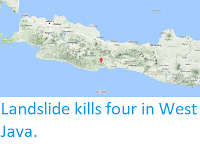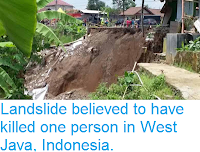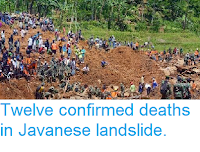Two people are known to have died and eight more are missing following a series of flooding and landslide events in West Java Province, Indonesia, this week. Both of the fatalities are reported to have occurred in the city of Bogor about 50 km to the south of Jakata. Only one of the dead has been identified, Dianti Dyah Ayu Putri, one of two women who were buried by a landslide in their car in the early hours of Tuesday 6 February 2018, who died of her injuries in hospital. Her companion Mukhmainah, who was trapped in the vehicle for several hours, is still being treated.
The scene of a landslide that buried two women in their car in Bogor, West Java, on 2 February 2018. Andika Panduwinata/Warta Kota.
Landslides are a common problem in Java, particularly during the Northeast Monsoon, which lasts from November to February, with peak rainfall in January and February, and can result in an annual
rainfall in excess of 4000 mm in parts of West Java. This problem has been made worse as expanding populations
has led to people farming higher on hillslopes, in an area where soils
tend to be volcanic in action and poorly consolidated (i.e. lack much
cohesion), making them more prone to landslides.
Monsoons
are tropical sea breezes triggered by heating of the land during the
warmer part of the year (summer). Both the land and sea are warmed by
the Sun, but the land has a lower ability to absorb heat, radiating it
back so that the air above landmasses becomes significantly warmer than
that over the sea, causing the air above the land to rise and drawing in
water from over the sea; since this has also been warmed it carries a
high evaporated water content, and brings with it heavy rainfall. In the
tropical dry season the situation is reversed, as the air over the land
cools more rapidly with the seasons, leading to warmer air over the
sea, and thus breezes moving from the shore to the sea (where air is
rising more rapidly) and a drying of the climate.
Diagrammatic representation of wind and rainfall patterns in a tropical monsoon climate. Geosciences/University of Arizona.
Java has two distinct Monsoon Seasons, with a Northeast Monsoon driven
by winds from the South China Sea that lasts from November to February
and a Southwest Monsoon driven by winds from the southern Indian Ocean from March to October. Such a double Monsoon Season is common
close
to the equator, where the Sun is highest overhead around the equinoxes
and lowest on the horizons around the solstices, making the solstices
the coolest part of the year and the equinoxes the hottest.
The winds that drive the Northeast and Southwest Monsoons in Southeast Asia. Mynewshub.
See also...
Follow Sciency Thoughts on Facebook.









